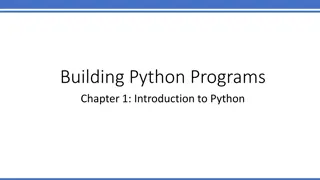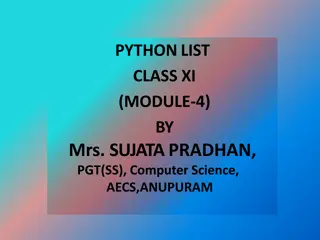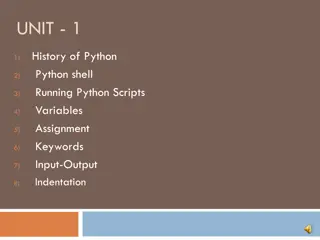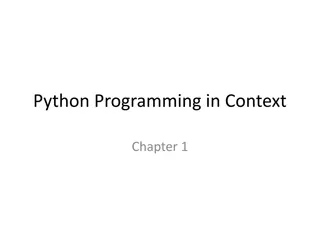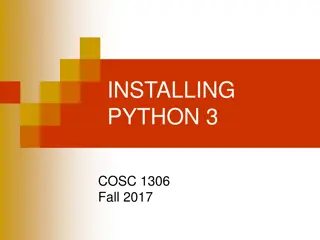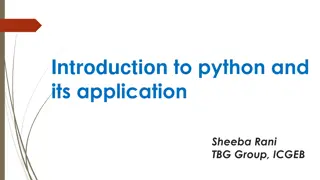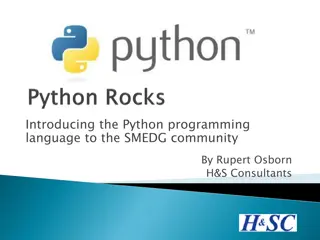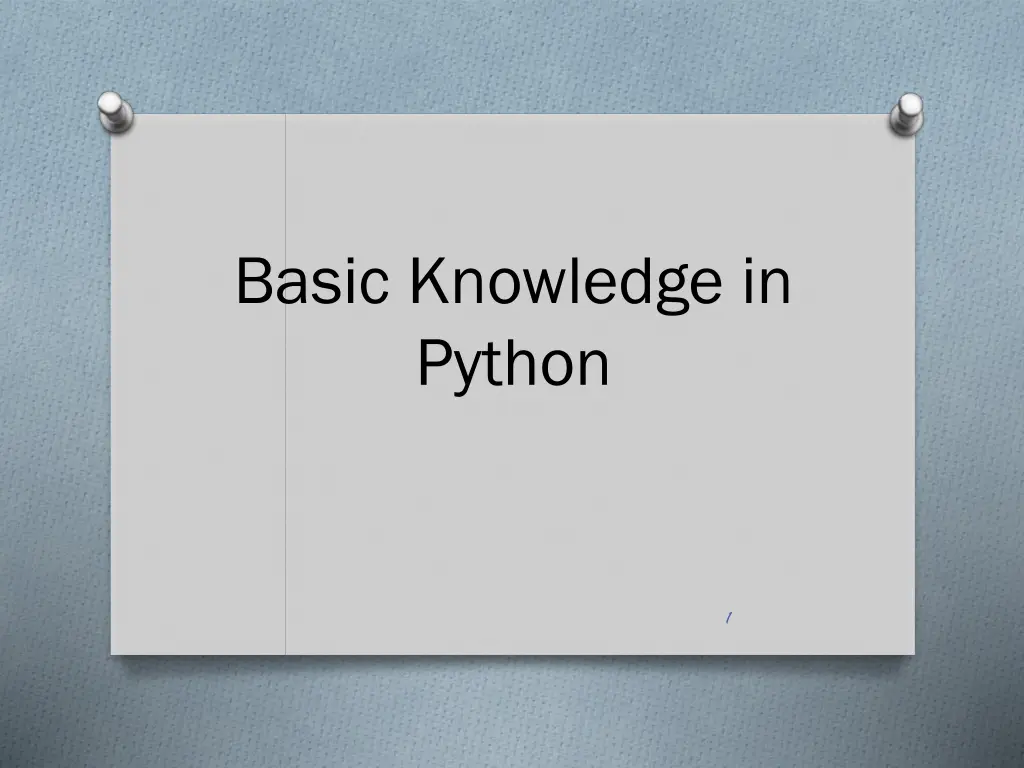
Introduction to Python Basics and Documentation
Explore the fundamental concepts in Python such as comments, escape sequences, data types, and typesetting of output. Learn the importance of commenting code, utilizing escape sequences, understanding different data types, and formatting output effectively. Dive into the basics with this insightful chapter on Python programming.
Download Presentation

Please find below an Image/Link to download the presentation.
The content on the website is provided AS IS for your information and personal use only. It may not be sold, licensed, or shared on other websites without obtaining consent from the author. If you encounter any issues during the download, it is possible that the publisher has removed the file from their server.
You are allowed to download the files provided on this website for personal or commercial use, subject to the condition that they are used lawfully. All files are the property of their respective owners.
The content on the website is provided AS IS for your information and personal use only. It may not be sold, licensed, or shared on other websites without obtaining consent from the author.
E N D
Presentation Transcript
Basic Knowledge in Python 1
Learning target O This chapter introduces:: 1. Comment 2. Escape symbol 3. Data type 4. Basic operators 5. The difference between = and == 6. Indentation 7. Multi-line representation
Comment O Comment is a short description added to the code for the readability O It is good for you and others to check the code O Comment symbol O Tell the Python compiler to ignore the text or comments following it 3
Comment O Single line Comment # Comments start with a # a = 10 # Comments can be placed at the end of a line O Multi-line comment O Using a multi-line string by triple (single or double) quotes O Triple quotes are treated as regular strings with the exception that they can span multiple lines O When the multi-line string is not assigned to a variable, the string will be immediately garbage collected as code executes a = 10 ''' multi-line string ''' c = 2 """ another multi-line string """ 4
Escape sequences Escape sequence Character represented \a \b \f \n \r \t \v Bell character Backspace character Formfeed character Newline character Carriage return character Tab character Vertical Tab character \\ Backslash character \? \' \" Question mark character Single-quote character Double-quote character 5
Typesetting of the output O The Newline(\n), Tab(\t), or blank O Clear to read and check output result can be typeset by 6
Typesetting of the output O E.g: num1=10 # Integer variable 1 num2=20 # Integer variable 2 print(num1) print() # Line wrapping method 1 print(num2) print("\n") # Line wrapping method 2 O Result: print(num1) print() 7 print("\n") print(num2)
Data type O During the execution of the program, a lot of information needs to be calculated and stored O The information is stored in the memory space O The required format vary with different types of data O Data type is designed for different types of data 8
Data type O Integer O Floating point number O String O Complex 9
Data type Integer = 100 # Integer Float = 1000.0 # Floating point String= "John" # A list of characters Complex= (-1+2j) # Complex number print(type(Integer)) print(type(Float)) print(type(String)) print(type(Complex)) O E.g: O Result: print(type(Integer)) print(type(Float)) print(type(String)) 10 print(type(Complex))
Basic operators O Arithmetic operators O Used in integers and floating-point numbers O The calculation results are also integers or floating-point numbers O Bitwise operators O Operate on the operands that are streams of binary bits (each bit is zero or one) 11
Basic operators O Assignment operator O Assign the value on the right side of the equal sign to the variable on the left O Relational operator O The result obtained by the equality or relational operator is Boolean value that is True or False 12
Basic operators O Arithmetic Operators: Operators + - * / // % Features Addition Subtraction Multiplication Division Floor division Modulus Example a + b a - b a * b a / b a // b a % b 13
Basic operators O Logical Operators : Operators << >> & | ^ Features Bitwise Left Shift Bitwise Right Shift Bitwise AND Bitwise OR Bitwise XOR Example a << n a >> n a & b a | b a ^ b 14
Basic operators O Assignment operator : Operators = Features Assign Add and assign later Subtract and assign later Multiply and assign later Divide and assign later Get the remainder and assign later Example a = b += a += b -= a -= b *= a *= b /= a /= b %= a %= b 15
Basic operators O Assignment operator : O a=a+b equivalent to a += b O a=a-b equivalent to a -= b O a=a*b equivalent to a *= b O a=a/b equivalent to a /= b O a=a%b equivalent to a %= b 16
Basic operators O Relational operator : Example a < b a > b Operators < > Features Less than Greater than Less than or equal to Greater than or equal to Equal Not equal and or <= a <= b >= a >= b == != and or a == b a != b (a>0)and(b>0) (a>0)or(b>0) 17
The difference between = and == O = symbol is used to assign a certain value to a variable O The == symbol is used to compare the left and right operands to see if they are equal or not 18
The difference between = and == O Example: integer=1 #Set the integer variable to 1 if(integer==1): #Test the equality of the variable integer and 1 print("integer equal 1") O Result: 19
Indentation O Indentation in Python refers to the spaces and tabs that are used at the beginning of a statement O The statements with the same indentation belong to the same group called a suite suite 20
Indentation O E.g : #An example of python code with correct indentation if a==1: print(a) if b==2: print(b) print('end') O E.g : #An example of python code with wrong indentation a = 1 print(a) a = 3# Multiple blanks, resulting in an error print(a) 21
Multi-line representation O Example : two=2 three=3 # Use \ to connect to the next line of code # Press Enter to automatically align total = one + \ two + \ three print(total) one=1 O Result: 22
Source O References O http://openhome.cc/Gossip/CppGossip/DataType.html O http://pydoing.blogspot.tw/2014/07/python-guide.html O http://www.w3cschool.cc/python/python-tutorial.html O https://msdn.microsoft.com/zh-tw/library/bx185bk6.aspx O Python
Exercise 1 O Design a program, where you have to declare two integer variables, one is set to 10 and the other is set to 20. Output the result of the addition, subtraction, and multiplication of the two variables. O Result:
Exercise 2 O Design a program that can print the multiplication table as follows. O Result: 1 1*1=1 2*1=2 3*1=3 4*1=4 5*1=5 6*1=6 7*1=7 8*1=8 9*1=9 2 1*2=2 2*2=4 3*2=6 4*2=8 5*2=10 6*2=12 7*2=14 8*2=16 9*2=18 3 1*3=3 2*3=6 3*3=9 4*3=12 5*3=15 6*3=18 7*3=21 8*3=24 9*3=27 4 1*4=4 2*4=8 3*4=12 4*4=16 5*4=20 6*4=24 7*4=28 8*4=32 9*4=36 5 1*5=5 2*5=10 3*5=15 4*5=20 5*5=25 6*5=30 7*5=35 8*5=40 9*5=45 6 1*6=6 2*6=12 3*6=18 4*6=24 5*6=30 6*6=36 7*6=42 8*6=48 9*6=54 7 1*7=7 2*7=14 3*7=21 4*7=28 5*7=35 6*7=42 7*7=49 8*7=56 9*7=63 8 1*8=8 2*8=16 3*8=24 4*8=32 5*8=40 6*8=48 7*8=56 8*8=64 9*8=72 9 1*9=9 2*9=18 3*9=27 4*9=36 5*9=45 6*9=54 7*9=63 8*9=72 9*9=81 1 2 3 4 5 6 7 8 9
Exercise 3 O Design a program that can print the Pascal s triangle with rows 0 through 7, as follows. O Result :







